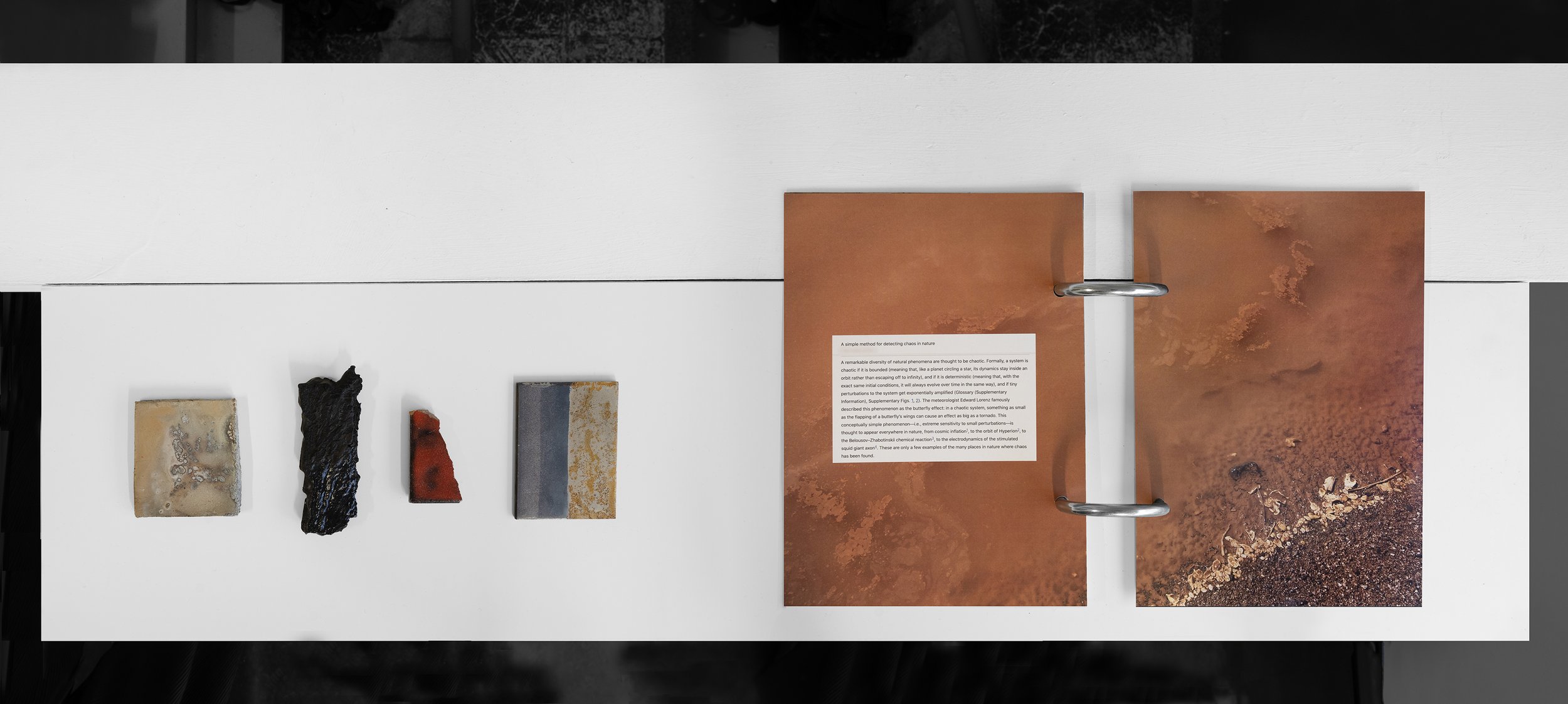JEN O’FARRELL
10 NOV - 16 DEC 2023
no longer endless
-
NO LONGER ENDLESS
TEXT BY HATTY NESTOR
Where are we rooted? Familiarity with land is something we are all attuned to, even if its hold on us is subtle. Whether materials are from local sites situated in the urban They are woven as common threads.~
How do you return from a place, and make people understand what you witnessed?
We are chatting on the phone and Jen relays the experience of witnessing the sun set and the moon rise in tandem in the Atacama Desert in Chile, a phenomenon known as an analemma, an elliptical orbit. I imagine how she might have felt the stillness of this, the fleeting atmospheric conditions, and the task of bringing something back from it to tell a story, materially. The desert, so intrinsically opposed to the concrete underbelly of London where Jen works, can be traced in her art. To Remain is partly made from bio-resin harvested from the Algarrobo trees she encountered in the desert: testament to the localised knowledge of the Licanantay people who have lived there for centuries.
In these works, we see salvaging from deserts, cities, and coastlines. Together, they create an ebb and flow in vision and form, feeling and function.
Extraction
Mining from the ground;
Pigments, salt, clay,
Evaporation, oxidisation, dyeing, staining; Bio-resin, spray paint, dirt from construction sites Are all painted onto salvaged materials from the desert and cityThese materials harbour a poetic force, a meandering of textures which coil and contort. Boundaries collapse, shapes erode and reform. The only consistency is this inherent change, where fluidity meets and merges and new worlds unfold through each curve, line, and fold. In Moments of Power, an iron sign is coupled with bio-resin and ink.
Several flows meander at different speeds, and the poetry of the past and present prevail from each movement, as impermanence.
The works are intuitively made, and the colours subsume me in No Longer Endless where reds, merge with beige, transfixed in a state of flux and liminality. In these works, movement transpires as a place of endless becoming – never rooted, fixed or static. It would be simple to see them as a capturing of time, a snapshot of the earth, but in the meandering of substances and forms, they become their own entity.
Dirt and metal are salvaged from construction sites, from the grit of the city. They are materials that speak to landscapes in flux, in transformation, where graffiti marks juxtapose the rural and man-made. Lust for Domination strikes industrious red lines of varnish and spray paint, oxidation and erosion allowing for change and contortion, akin to London’s matrix.
The colour palette transitions from light to dark, like day to night. This contrast allows the present to come into focus, not through stasis but through the tapestry of these textures.
~
There is a conversation here, a dialogue between women who have been situated within desert horizons.
I am thinking of Lucy Lippard: What and where does the boundary of ‘land art’ begin?
She talks of land art as ‘a pseudo rural art made from metropolitan headquarters, a kind of colonisation in itself.’ Jen’s approach interrogates these acts of displacement: what it means to extract, the politics of taking raw materials from the earth – specifically in Chile where copper and nitrate are mined, alongside lithium in the Atacama Desert. Her process involves salvaging materials, foraging clay and dirt and harvesting bio-resin, followed by processes of layering, oxidation, erosion, and evaporation back in her London studio. By juxtaposing fragments of the desert with the city,
Jen – like Lippard – interweaves locality with wider global climate issues through materiality and gesture.
I am further reminded of Lippard sitting out across the Northern New Mexico desert near Galisteo where she has lived since 1992. She ponders across the vast landscape punctured by creosote bushes and agave plants; I know this desert well, having grown up partly in Santa Fe. I have sand from the Southwest in London, and knowing these desert terrains, I feel an intimacy with this process, and therefore an intimacy with Jen.
I can imagine what it means to collect and combine, to move and cultivate.
This exchange of how materials travel and find themselves in new terrains feels pertinent – a testament to what is permitted to be moved and reappear within the urban.
We are returning to the elemental, through the industrial and the rural, with the realisation that we may be –
No Longer Endless
-
JEN O’FARRELL (b.1990, Liverpool) is an artist living and working in London.
O’Farrell’s abstract works formally evoke the topographies of industrial inner-city landscapes, remote terrains and geological formations, using materials sourced directly from both urban and natural sites. By embedding locality into the very fabric of the work, O’Farrell’s practice pays poetic homage to these environments, while also reflecting more widely on issues of ecological decline, the extractive exploitation of raw materials and the fault lines of concrete capitalism.
Her work has been exhibited at South London Gallery, London; The V&A Museum, London; Nicoletti Contemporary, London. Residencies include La Wayaka Current, Atacama Desert, Chile, and Conditions Studio Programme, London.


















